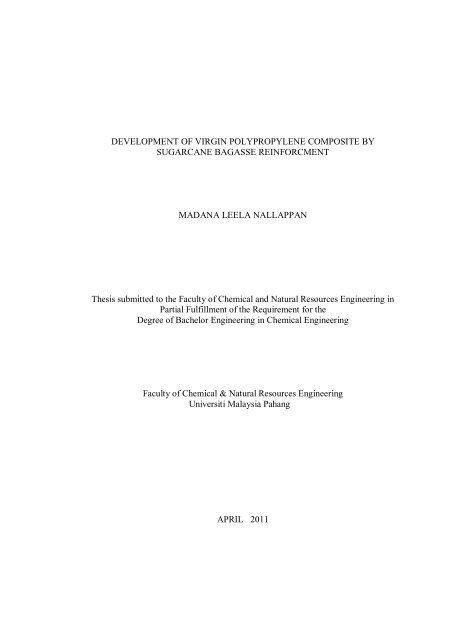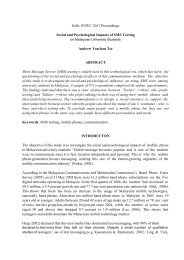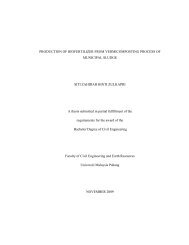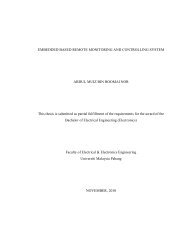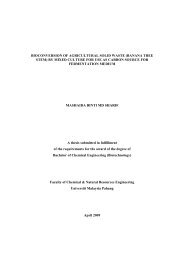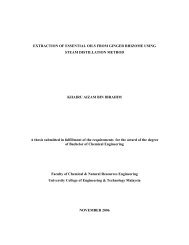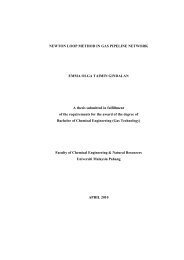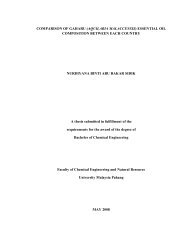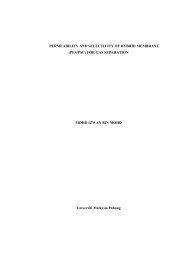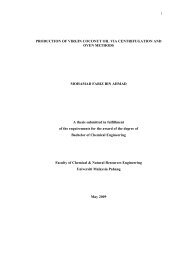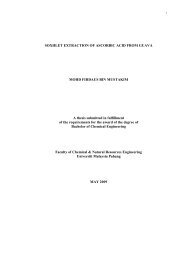CHAPTER 1 - Universiti Malaysia Pahang
CHAPTER 1 - Universiti Malaysia Pahang
CHAPTER 1 - Universiti Malaysia Pahang
Create successful ePaper yourself
Turn your PDF publications into a flip-book with our unique Google optimized e-Paper software.
DEVELOPMENT OF VIRGIN POLYPROPYLENE COMPOSITE BY<br />
SUGARCANE BAGASSE REINFORCMENT<br />
MADANA LEELA NALLAPPAN<br />
Thesis submitted to the Faculty of Chemical and Natural Resources Engineering in<br />
Partial Fulfillment of the Requirement for the<br />
Degree of Bachelor Engineering in Chemical Engineering<br />
Faculty of Chemical & Natural Resources Engineering<br />
<strong>Universiti</strong> <strong>Malaysia</strong> <strong>Pahang</strong><br />
APRIL 2011
ABSTRACT<br />
This research is aimed to produce a high strength composite by reinforcement<br />
sugarcane bagasse as filler into virgin polypropylene. Bagasse fiber is a by-product<br />
of the sugar cane industry whose role is sugar or biofuel production. The bagasse<br />
filler is divided into two parent categories which are the pith and the rind. This study<br />
is focused on the determination of the optimum fibre content which gives maximum<br />
strength for each parent category and establishing which parent category gives<br />
optimum results with respect to strength. For each category extrusion was carried out<br />
at a temperature of 190 o C and screw speed of 50 to 70rpm, for fibre content of 10<br />
wt% to 50 wt%. The compounded samples were then prepared into test specimens<br />
through injection molding and characterized by tensile testing, Fourier Transform<br />
Infrared Spectroscopy (FTIR) and Melt Flow Index (MFI). Based on the tests, the<br />
fibre content that gives the maximum strength is identified. Comparisons are made<br />
and it is established that the rind gives better strength as filler, compared to the pith<br />
and that a 30 wt% fibre composition gives maximum strength.<br />
ii
ABSTRAK<br />
Objektif kajian ini adalah bertujuan untuk menghasilkan composite yang<br />
berkekuatan tinggi dengan menggunakan hampas tebu sebagai pengisi didalam<br />
polypropylene tulen. Serat tebu merupakan produk sampingan industri tebu yang<br />
berperanan untuk menghasilkan gula atau biofuel. Hampas atau serat tebu boleh<br />
dibahagikan kepada dua kategori induk iaitu serat buah dan serat kulit. Penyelidikan<br />
ini berfokuskan kepada pengenalpastian kandungan serat optimum yang memberikan<br />
kekuatan maximum bagi setiap kategori induk serta menentukan kategori induk yang<br />
memberikan hasil kajian yang optimum berdasrkan kepada kekuatan. Extrusion<br />
dijalankan bagi setiap kategori pada suhu 190 o C kelajuan skru dalam lingkungan 50<br />
hingga 70rpm, bagi kandungan serat 10 wt% hingga 50 wt%. Sample yang telah<br />
dikmpoun kemudianya dijadikan sample ujian melalui “injection molding” dihantar<br />
untuk kajian “tensile testing”, Fourier Transform Infrared Spectroscopy (FTIR) and<br />
Melt Flow Index (MFI). Berdasarkan ujian yang dilakukan, komposisi serat yang<br />
memberikan kekuatan yang maksimum ditentukan. Perbandingan dilakukan dan<br />
dikenalpasti bahawa serat kulit memberikan lebih kekuatan sebagai bahan pengisi<br />
berbandig dengan serat buah. Juga dikenalpasti bahawa komposisi serat 30 wt%<br />
memberikan kekuatan yang maksimum.<br />
iii
TABLE OF CONTENTS<br />
<strong>CHAPTER</strong> TITLE PAGE<br />
DECLARATION<br />
DEDICATION<br />
ACKNOWLEDGEMENT i<br />
ABSTRACT ii<br />
ABSTRAK iii<br />
TABLE OF CONTENTS iv<br />
LIST OF TABLES vi<br />
LIST OF FIGURES vii<br />
1.0 INTRODUCTION 2<br />
1.1 Background of Study 2<br />
1.2 Problem Statement 5<br />
1.3 Objective 6<br />
1.4 Scope of Research 6<br />
2.0 LITERATURE REVIEW 7<br />
2.1 Introduction 7<br />
2.2 Polypropylene Composites 8<br />
2.3 Bagasse Composites 13<br />
3.0 MATERIALS AND METHODS<br />
3.1 Introduction 15<br />
3.2 Materials 16<br />
3.3 Method of Research 18<br />
iv
4.0 RESULTS AND DISCUSSION 21<br />
4.1 Introduction 21<br />
4.2 Tensile Strength, Young’s Modulus & Break Strain 22<br />
4.3 Melt Flow Index 27<br />
4.4 Density 28<br />
4.5 FTIR 30<br />
5.0 CONCLUSION AND RECOMMENDATION 31<br />
REFERENCES<br />
v
LIST OF TABLES<br />
TABLE NO. TITLE PAGE<br />
3.1 Properties of Polypropylene 15<br />
4.1 Tensile Result Table for Different 21<br />
Rind Composition<br />
4.2 Tensile Result Table for Different 22<br />
Pith Composition<br />
4.3 Melt Flow Index for Pith & Rind Composites 26<br />
4.4 Density of Pith & Rind Composites 27<br />
4.5<br />
vi
LIST OF FIGURES<br />
FIGURE NO. TITLE PAGE<br />
2.1 Chemical structure of cellulose monomer 10<br />
3.1 Sugarcane Stalk 17<br />
3.1 Flowchart of Research Methodology 19<br />
4.1 Graph of Tensile Strength vs. Fibre 23<br />
Composition<br />
4.2 Graph of Young’s Modulus vs. Fibre 23<br />
Composition<br />
4.3 Graph of Break Strain vs. Fibre Composition 24<br />
4.4 Graph of Melt Flow Index vs. Composition 26<br />
4.5 Graph of Density vs. Fiber Composition 28<br />
4.6 FTIR Spectra for Pith & Rind Fibers 29<br />
vii
1.1 Background of the Study<br />
<strong>CHAPTER</strong> 1<br />
INTRODUCTION<br />
Driven by increasing environmental awareness, automakers in the 1990s made<br />
significant advancements in the development of natural fiber composites, with end-<br />
use primarily in automotive interiors. A number of vehicle models, first in Europe<br />
and then in North America, featured natural fiber-reinforced thermosets and<br />
thermoplastics in door panels, package trays, seat backs and trunk liners. Promoted<br />
as low-cost and low-weight alternatives to fiberglass, these agricultural products,<br />
including flax, jute, hemp and kenaf, signaled the start of a "green" industry with<br />
enormous potential<br />
The prominent advantages of natural fibers include acceptable specific strength<br />
properties, low cost, low density and high toughness (Biagiotti et al., 2004). The<br />
mechanical properties of some natural fibers such as jute, sisal, and flaw fibers were<br />
compared to glass fibers and it was observed that specific moduli of these fibers are<br />
comparable to or better than those of glass fibers (Nabi Saheb et al., 1999 ) . The<br />
physical and mechanical properties of wood, water hyacinth, Kenaf, banana and<br />
1
empty fruit bunch of oil palm fibers filled polypropylene composites has been<br />
reported (Myrtha Karina et al., 2007 ).<br />
Different composites based on polypropylene and reinforced with flax and glass<br />
have been made and their mechanical properties are measured together with the<br />
distribution of the fiber size and the fiber diameter( Amirhossein Esfandiari, 2007).<br />
Composites of polypropylene and four different types of natural fibers including<br />
wood flour, rice hulls, kenaf fibers, and newsprint were prepared at 25 and 50% fiber<br />
contents and their dynamic mechanical properties were studied and compared with<br />
the pure plastic ( Mehdi Tajvidi et al., 2006). The mechanical properties of bamboo<br />
fiber- reinforced polypropylene composites are compared with commercially<br />
available wood pulp board and it is reported that bamboo fiber composites are<br />
lighter, water-resistant, cheaper and has more tensile strength than wood pulp<br />
composites (Xiaoya Chen et al., 1998). A systematic study of the mechanical<br />
properties of the composites as a function of fiber loading, and fiber treatment time<br />
has been made for sisal polypropylene composites (Smita Mohanty et al., 2004,<br />
P.V.Joseph et al., 1999).<br />
This study is focused on reinforcing polypropylene with sugarcane bagasse<br />
which is a waste from the sugar industry. For each 10 tonnes of sugarcane crushed, a<br />
sugar factory produces nearly 3 tonnes of wet bagasse. Since bagasse is a by-product<br />
of the cane sugar industry, the quantity of production in each country is in line with<br />
the quantity of sugarcane produced. Generally, bagasse is stored prior to further<br />
processing. For electricity production, it is stored under moist conditions and the<br />
mild exothermic reaction which results from the degradation of residual sugars dries<br />
the bagasse pile slightly. For paper and pulp production, it is normally stored wet in<br />
order to assist in removal of the short pith fibres which impede the papermaking<br />
process as well as to remove any remaining sugar.<br />
Bagasse is an extremely inhomogeneous material comprising around 30-40% of<br />
"pith" fibre which is derived from the core of the plant and is mainly parenchyma<br />
material, and "bast", "rind" or "stem" fibre which comprises the balance and is<br />
largely derived from sclerenchyma material.<br />
2
Below follows a list of abbreviations and concepts that needs to be defined and<br />
clarified. These concepts will be used throughout the paper and therefore it is<br />
important to explain how they will be used to prevent misinterpretations as well as<br />
increase the understanding of the paper.<br />
a) Matrix phase of fibre-reinforced composites serves several functions.<br />
First, it binds the fibres together and acts as a medium by which an<br />
externally applied stress is transmitted and distributed to the fibres; only a<br />
very small proportion of an applied load is sustained by the matrix phase.<br />
Secondly, the matrix protects the individual fibres from surface damage<br />
as a result of mechanical abrasion or chemical reactions with the<br />
environment. Finally, the matrix separates the fibres and, by virtue of its<br />
relative softness and plasticity, prevents the propagation of brittle cracks<br />
from fibre to fibre.<br />
b) Filler is an inert material added to a polymer to improve its properties<br />
and/or to reduce its cost. On being mixed with the polymer resin, it forms<br />
a heterogeneous mixture which can be molded under the influence of heat<br />
or pressure.<br />
c) Bagasse Pith is derived from the core of the sugarcane stalk and consists<br />
mainly of parenchyma material.<br />
d) Bagasse Rind surrounds the core of the sugarcane stalk and is largely<br />
derived from sclerenchyma material<br />
e) Extrusion is the molding of a viscous thermoplastic under pressure<br />
through an open-ended die. In this research however the extrusion process<br />
also provides a means for the compounding of the natural fibre into the<br />
polymer matrix. A set of twin screws propels through a chamber into<br />
which the polymer pellets and fibre are fed. The polymer pellets are<br />
melted by a series of heaters, the propelling screws act as a blending<br />
medium for the compounding of the plastic and fiber. Extrusion takes<br />
3
place as this molten and blended mass is forced through a die orifice in a<br />
continuous charge.<br />
f) Injection Molding is used to mold most thermoplastic and some<br />
thermosetting material. The technique of injection molding consists of<br />
heating a charge to a consistent state of fluidity and transferring it under<br />
pressure by enclosed channels into a closed mold cavity where it is cooled<br />
to produce a solid product with the greatest degree of homogeneity. The<br />
high pressure is applied hydraulically through a plunger. The cooled<br />
object is physically ejected from the machine. The entire cycle is carried<br />
out in the shortest time.<br />
1.2 Problem Statement<br />
The need for minimizing the usage of plastic for the benefit of the environment<br />
has led to study ways on filling the plastic with natural fibres which would produce<br />
composite materials comparable (or better) in strength when compared with the<br />
plastic or composites derived from inorganic fibres such as fibre-glass. Substituting a<br />
large fraction of the plastic for natural fibre filler and maintaining or subsequently<br />
improving the strength of the material would be significant in reducing the world<br />
plastic consumption. Replacing inorganic fillers like fibre-glass would significantly<br />
reduce the cost of the material and also do the environment a favour because the<br />
production of natural fiber suitable for composites is some 60 percent lower in<br />
energy consumption than the manufacture of glass fibers.<br />
4
1.3 Objective<br />
The objective of this research is focused on the identification of sugarcane<br />
bagasse pith or rind as potential filler in producing a composite from virgin<br />
polypropylene.<br />
1.4 Scope of Research<br />
on:<br />
To accomplish the objective of this study, the scope of this research is focuses<br />
a) Blending of bagasse (pith & rind) and virgin polypropylene through extrusion<br />
b) Preparation of test specimens by injection molding<br />
c) Study of the parameters to be tested and improved :<br />
i. Tensile Strength (Bending)<br />
ii. Elongation at Break<br />
iii. Modulus Of Elasticity (Young’s Modulus)<br />
iv. Melt Flow Index (MFI)<br />
5
2.1 Introduction<br />
<strong>CHAPTER</strong> 2<br />
LITERATURE REVIEW<br />
The most important aspects to concentrate on in producing a natural fibre<br />
reinforced composite is in determining the suitability of the fibre as reinforcement<br />
material and to identify properties or parameters that can be manipulated to produce<br />
a better strength composite. This research is focused on determining the most<br />
suitable part of the sugarcane that can be used as filler in virgin polypropylene. The<br />
two parts in focus here are the pith and the rind of sugarcane bagasse. Also to be<br />
discovered is the suitability of the usage of polypropylene as a matrix in composites.<br />
6
2.2 Polypropylene Composites<br />
2.2.1 Properties of Kenaf/Polypropylene Composites<br />
Combining kenaf fiber with other resources provides a strategy for producing<br />
advanced composite materials that take advantage of the properties of both types of<br />
resources. It allows the scientist to design materials based on end-use requirements<br />
within a framework of cost, availability, recyclability, energy use, and environmental<br />
considerations. Kenaf fiber is a potentially outstanding reinforcing filler in<br />
thermoplastic composites. The specific tensile and flexural moduli, for example, of a<br />
50% by volume of kenaf-polypropylene (PP) composite compares favourably with a<br />
40% by weight of glass fibre-PP injection molded composite. Results indicate that<br />
kenaf fibres are a viable alternative to inorganic/mineral-based reinforcing fibres as<br />
long as the right processing conditions and aids are used, and for applications where<br />
the higher water absorption of the lignocellulosic-based fibre composite is not<br />
critical.<br />
From this study it is discovered that natural fibres are a potential replacement<br />
for inorganic fibres. (Roger M. Rowell et al., 2007)<br />
2.2.2 Tensile strength of elephant grass fibre reinforced<br />
polypropylene composites<br />
The main objective of this paper was an Elephant grass fibre(Scientific name:<br />
Pennisetum purpureum), is identified as potential reinforcement for making<br />
composites. Elephant grass fiber reinforced polypropylene matrix composites have<br />
7
een developed by injection molding technique with varying percentages of weight<br />
(0%, 10%, 15%, 20%, and 25%). The developed composites were then tested for<br />
their tensile Properties.<br />
Vegetation associated with agriculture and forestry is a large source for<br />
extracting fibers, which has been largely under utilized. Fibers that can be extracted<br />
from the vegetation with water retting process are inexpensive.<br />
The process of extraction of Elephant grass fiber is simple and results in an<br />
excellent quality of fiber. 10 percent fiber weight composites has better tensile<br />
strength compared 5, 15, 20&25 weight percent fiber composites. 25 percent fiber<br />
weight composites have better tensile modulus compared to other fiber weight<br />
percentage composites.<br />
The density of the Elephant grass fiber is less than that of well established<br />
natural and synthetic fibers. So, elephant grass fiber can be used as natural<br />
reinforcement in the composites for the design of light weight materials. (N. Ravi<br />
Kumar et al., 2008)<br />
This study explores the possibility of elephant grass as a substitute for<br />
inorganic fibres as filler for polypropylene composites. It informs the methods by<br />
which the fibre is prepared and compounded with the polypropylene matrix and how<br />
the resulting composite is tested for strength.<br />
2.2.3 Mechanical and Morphological Properties of Sisal/Glass Fibre-<br />
Polypropylene Composites<br />
Natural fiber reinforced polymer composites became more attractive due to<br />
their light weight, high specific strength, biodegradability. However, some<br />
limitations e.g. low modulus, poor moisture resistance were reported. The<br />
mechanical properties of natural fiber reinforced composites can be improved by<br />
8
hybridization with synthetic fibers such as glass fiber. In this research, mechanical<br />
properties of short sisal-PP composites and short sisal/glass fiber hybrid composites<br />
were studied. Polypropylene grafted with maleic anhydride (PP-g-MA) was used as a<br />
compatibilizer to enhance the compatibility between the fibers and polypropylene.<br />
Effect of weight ratio of sisal and glass fiber at 30 % by weight on the mechanical<br />
properties of the composites was investigated. Morphology of fracture surface of<br />
each composite was also observed. (Kasama Jarukumjorn et al., 2008)<br />
2.2.4 Improvement of Physico-Mechanical Properties of Jute Fibre<br />
Reinforced Polypropylene Composites by Post-treatment<br />
Jute fiber reinforced polypropylene composites were manufactured using<br />
injection molding method. Raw jute fiber was oxidized and manufactured composites<br />
were post-treated with urotropine. Both raw and oxidized jute fiber at four level of<br />
loading (20, 25, 30 and 35 wt%) was utilized during manufacturing. Microstructural<br />
analysis and mechanical tests were conducted. Post-treated specimens yielded better<br />
mechanical properties compared to the oxidized and raw ones. Based on fiber<br />
loading, 30% fiber reinforced composites had the optimum set of mechanical<br />
properties. Authors propose that the bonding between the polypropylene matrix and<br />
urotropine treated jute fiber must be improved in order to have better mechanical<br />
properties at higher fiber content. (Md. Rezaur Rahman et al., 2008)<br />
2.2.4 Mechanical Properties of Flax Fibres and Their Composites<br />
Generally, plant or vegetable fibers are used to reinforce plastics. The main<br />
polymers involved in the composition of plant fibers are cellulose, hemicelluloses,<br />
lignin and pectin. Let us consider very popular flax fibers to understand the intricate<br />
structure of plant fibers. The ~1 meter long so-called technical fibers are isolated<br />
from the flax plant for the use in textile industry. These technical fibers consist of<br />
9
elementary fibers with lengths generally between 2 and 5 cm, and diameters between<br />
10 and 25 m. The elementary fibers are glued together by a pectin interface. They are<br />
not circular but a polyhedron with 5 to 7 sides to improve the packing in the<br />
technical fiber. What are elementary fibers? They are single plant cells. And<br />
cellulose (C6H10O5)n is a common material in plant cell walls. It occurs naturally in<br />
almost pure form in cotton fiber. Chemical structure of cellulose monomer is<br />
represented in Figure 3. Most of the elementary fiber consists of oriented, highly<br />
crystalline cellulose fibrils and amorphous hemicelluloses. The crystalline cellulose<br />
fibrils in the cell wall are oriented at an angle of about ±10 degrees with the fiber<br />
axis and give the fiber its high tensile strength.<br />
Figure 2.1: Chemical structure of cellulose monomer<br />
Thermoplastic natural fibre reinforced (NFC) is manufactured mainly by<br />
different extrusion methods followed by injection or compression molding. Fibres<br />
are chopped during process therefore composites have short fibers (few millimeters<br />
at most). Orientation is three-dimensional, but not necessarily isotropic (depends on<br />
method: injection process, shape of mould etc.). Besides, natural fiber mat<br />
thermoplastic composite plates with different fiber contents can be manufactured<br />
using the film-stacking method. Thermoplastic pultrusion can also be applied for<br />
continuous process. Compression molding processes is very typical for thermosets.<br />
Resin transfer molding and resin infusion are used as well. These methods ensure<br />
relatively longer fibers and more or less inplane orientation in resulting composite.<br />
Since the thermal stabilityof the flax fibers may be increased by chemical treatment,<br />
then even autoclave molding technique can be applied.A very important task of NFC<br />
10
manufacturing is to have elementary fibre, not technical fibre, as the reinforcement in<br />
the composite. On the other hand, using technical fibres or textile yarns, it is possible<br />
make long fibre composites with predefined fibres orientation. However in both<br />
cases the basic problem is fibre/matrix adhesion.<br />
All the plant fibres are hydrophilic in nature. That is because of their<br />
chemical structure the hemicelluloses and the pectin are very hydrophilic. In<br />
contrary, many of the common matrix polymers in composites are largely<br />
hydrophobic in nature. Only thermosets such as phenol formaldehyde and related<br />
polymers are less hydrophobic and are therefore less problematic. This discrepancy<br />
can lead to the formation of ineffective interfaces between the fiber and matrix.<br />
Problem can be solved applying different fiber treatments (both chemical and<br />
mechanical) or modifying chemical composition of the matrix. Unfortunately,<br />
surface treatments have a negative impact on economical aspect of NFC<br />
manufacturing. There are many publications reporting that properties of PP based<br />
composites are improved using maleic anhydride grafted PP (MAPP) as matrix<br />
additive. The same MAPP, acetilation and stearic acid treatment are used for fiber<br />
processing. Adhesion increases also after boiling of the flax fibres. For epoxy resin,<br />
alkali (NaOH), silane (3-aminopropyltriethoxysilane), isocyanate (phenyl<br />
isocyanate), urea and other treatments can be employed. Acrylic acid and vinyl<br />
trimethoxy silane of different concentrations are considered for several other<br />
thermosets. (M. Janarthanan et al., 2007)<br />
This paper gives an over view of natural fiber reinforced composites, the<br />
advantages of using natural fibres, the problems faced with natural fibres and ways to<br />
improve adhesion.<br />
11
2.3 Bagasse Composites<br />
2.3.1 Silane Treatment of Bagasse Fiber for Reinforcement of<br />
Cementitious Composites<br />
Silane coating of fibers is a promising process for improving durability and<br />
adhesion of vegetable fibers used as reinforcement material in a cementitious matrix.<br />
The work presented in this paper gives an insight into the effect of combining<br />
pyrolysis treatment with silane treatment. Indeed, this study focuses on silane<br />
treatment of unpyrolyzed and pyrolyzed sugar cane bagasse fibers with an<br />
alkyltrialkoxysilane (RSi(OR0)3), S1 or a dialkyldialkoxysilane (R2Si(OR00)2), S2.<br />
The silane solutions used vary from 0.5% to 8% by volume. This paper describes the<br />
effect of two silane compounds on parameters such as the porosity, dimension,<br />
morphology and hygroscopic character of silane-coated sugar cane bagasse fibers.<br />
Preliminary studies on natural fiber reinforced composite setting time show the<br />
importance of the silane chemistry/structure, for fiber treatments with silane solution<br />
containing up to 6% (volume percent) silane. In the case of composites reinforced<br />
with unpyrolyzed bagasse fibers, setting time increases with silane coating.<br />
Combining pyrolysis and silane treatment improve the water resistance of the fibers,<br />
which become more hydrophobic.<br />
The advantage of vegetable fibre reinforced cement composites (VFRC) lies<br />
in the improvement of mechanical and thermal properties, and in the reasonable cost.<br />
However, the wide use of these materials is hampered by their low stability. The<br />
vegetable fibre in the porous alkaline matrix is slowly damaged and the reinforcing<br />
effect of the fibre decreases. To improve aging of the VFRC, two techniques were<br />
tested: (1) modification of the matrix and (2) fibre treatment. This second approach<br />
can have the advantage of improving the fibre–matrix interface. In the case of VFRC<br />
with kraft or hardwood, silane treatment has been found to increase moisture-cycling<br />
resistance. The effects of silane treatment on mechanical properties vary with the<br />
12
nature of the vegetable fibre: silane treatment increases toughness of newspaper and<br />
kraft fibre-cement while the modulus of rupture (MOR) and the modulus of elasticity<br />
(MOE) decrease for newspaper fibre-cement and increase for kraft fibre-cement.<br />
(K.Bilba et al., 2008)<br />
This study provided a means of identifying the weaknesses of sugarcane<br />
bagasse fibre and ways to handle them. This would be of help to enhance the strength<br />
of the resulting composite.<br />
2.3.2 Utilization of Bagasse in New Composite Building Materials<br />
This paper describes two composite building material systems and processes<br />
that utilize major percentages of bagasse filler and minor amounts of phenolic binder.<br />
Their composite concept, the choice of bagasse filler and the selection of the binder<br />
resin, is sound based on a thorough Rve-year research investigation. The phenolic<br />
bonded composite building materials developed are identified as bagasse-phenolic<br />
and oriented bagasse-phenolic. Potential applicatlons of these composites in home<br />
and commercial building are wall panels, ceiling, roofing, flooring, counter tops,<br />
fences, siding, acoustical panels, sinks, furniture, doors, and shutters. The product<br />
can be economically manufactured in any geographic location that produces<br />
signlficant quantities of sugar cane. This work represents a substantial technological<br />
breakthrough in value upgrading and utilization of the plentiful agricultural residue<br />
bagasse and merits further development leading to commercialization. (Ival 0. Salyer<br />
et al., 1982)<br />
In this study the possibility of using bagasse as filler in composite materials is<br />
explored. It helped in the identification of the components of bagasse and the ways to<br />
handle the fibre to optimize its strength.<br />
13
3.1 Introduction<br />
<strong>CHAPTER</strong> 3<br />
MATERIALS AND METHODS<br />
This research was divided into two categories, whereby the experiment was<br />
conducted using the pith and the rind bagasse fibres exclusively.<br />
In this study extrusion process is used to compound the bagasse fibre and<br />
polypropylene followed by an injection molding process to form test specimens. This<br />
process route is chosen as it provides a homogenous blend of fibre and matrix. The<br />
composites were developed with 0, 10, 20, 30, 40 and 50% (by weight) of pith and<br />
rind fibre.<br />
14
3.2 Materials<br />
3.2.1 Polypropylene<br />
Polypropylene (PP), also known as polypropene, is a thermoplastic<br />
polymer, made by the chemical industry and used in a wide variety of applications,<br />
including packaging, textiles (e.g. ropes, thermal underwear and carpets), stationery,<br />
plastic parts and reusable containers of various types, laboratory equipment,<br />
loudspeakers, automotive components, and polymer banknotes. An addition polymer<br />
made from the monomer propylene, it is rugged and unusually resistant to many<br />
chemical solvents, bases and acids. Most commercial polypropylene is isotactic and<br />
has an intermediate level of crystallinity between that of low-density polyethylene<br />
(LDPE) and high-density polyethylene (HDPE). Polypropylene is normally tough<br />
and flexible, especially when copolymerized with ethylene. This allows<br />
polypropylene to be used as an engineering plastic, competing with materials such as<br />
ABS. Polypropylene is reasonably economical, and can be made translucent when<br />
uncolored but is not as readily made transparent as polystyrene, acrylic, or certain<br />
other plastics. It is often opaque or colored using pigments. Polypropylene has good<br />
resistance to fatigue.<br />
IUPAC<br />
Name<br />
Table 3.1: Properties of Polypropylene<br />
poly(propene)<br />
15
Other Names Polypropylene; Polypropene;<br />
Molecular<br />
Formula<br />
Molecular<br />
Structure<br />
Polipropene 25 [USAN];Propene polymers;<br />
Propylene polymers; 1-Propene<br />
(C3H6)n<br />
Density 0.946 g/cm 3 , crystalline<br />
Melting Point 130–171 °C<br />
CAS number 9003-07-0<br />
3.2.2 Sugarcane Bagasse<br />
Sugarcane (Saccarhum officinarum) bagasse is a residue produced in large<br />
quantities by sugar industries. In general, 1 ton of sugarcane bagasse generates 280<br />
kg of bagasse, the fibrous by-product remaining after sugar extraction from<br />
sugarcane. However, the utilization of sugarcane bagasse is still limited and is<br />
mainly used as a fuel to power the sugar mill. A typical chemical analysis of bagasse<br />
might be (on a washed and dried basis):<br />
- Cellulose 45–55%<br />
- Hemicellulose 20–25%<br />
- Lignin 18–24%<br />
- Ash 1–4%<br />
- Waxes
3.3 Method of Research<br />
3.3.1 Extraction of Fibre<br />
Figure 3.1: Sugarcane Stalk<br />
In this method, the before crushing the sugarcane stalks are skinned first to<br />
obtain the rind. After that, the sugarcane stalks are crushed (this remove the sweet<br />
juice within) to obtain the pith. Both the pith and rind are washed to remove any<br />
excess sugar contained within and then dried under sunlight or in an oven at 60-75 o C<br />
to remove moisture content. This is done in order to prevent fungal growth. Once<br />
dry, the pith and the rind are ground separately.<br />
Rind<br />
Pith<br />
17
3.3.2Composite Fabrication<br />
An oven of size 450 X 450 X 450 mm (model CIC-12) is used to dry the<br />
extracted fibres and the polypropylene pellets at 80 o C to remove any moisture on<br />
remaining. For each category (i.e. the rind and the pith) proper portions of fibres (0,<br />
10, 20, 30, 40 and 50% by weight) and polypropylene pellets were thoroughly mixed<br />
to obtain a mixture of 250g total raw material per composition. Each composition<br />
was then extruded using a twin screw extruder. The temperature was set at of 190 o C<br />
and the screw speed at 70 -170rpm. Through this composites of different weight<br />
fractions were developed for each category.<br />
The extruded material is then pelletized to form pellets. The pellets are then<br />
injection molded using Nissei Injection Molding Machine to form dumbbell shaped<br />
test specimens. The injection molding is carried out at 190 o C and a pressure of 28%.<br />
3.3.3Testing<br />
A 5kN loaded universal tensile testing machine was used to measure the<br />
tensile properties. The samples were tested at a crosshead speed of 3mm/min. Five<br />
samples were tested for each composition from each category. The density of the<br />
composite was measured using gas pycnometric procedure. The flow properties of<br />
the composites were also measured using a Melt Flow Index machine.<br />
18
The sugarcane fiber (pith & rind) is washed and<br />
dried at 80 oC, then ground<br />
Virgin polypropylene is<br />
mixed with a<br />
PITH FIBER content of<br />
10wt% to 50wt% for 250g<br />
total raw material<br />
Figure 3.2: Flowchart of Research Methodology<br />
Virgin polypropylene is<br />
mixed with a<br />
RIND FIBER content of<br />
10wt% to 50wt% for 250g<br />
total raw material<br />
Sugarcane fiber (pith & rind) and virgin polypropylene are<br />
blended through extrusion<br />
at temp 190 o C and screw speed 70-170rpm<br />
The compounded material is then injection molded at a<br />
temperature of 170 o C and pressure of 28%<br />
The specimens are then subjected to tensile testing,<br />
density and MFI determination<br />
The tensile strength, elongation modulus and<br />
break strain<br />
19


